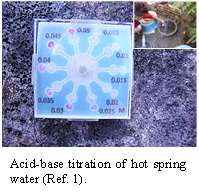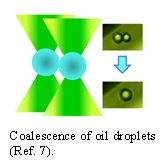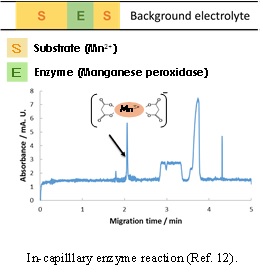Research
Projects
- Paper-based analytical devices for on-site analysis
- Analytical methods for exosomes
- High performance analytical methods for biological molecules by capillary electrophoresis
Paper-based analytical devices for on-site analysis
Paper-based analytical devices (PADs) have recently attracted a great deal of interest due to a simple structure, easy fabrication, lightness of weight, inexpensive materials, and rapid analysis. Our aim is to achieve real on-site analysis, that is, to develop the PADs which actually work in the field. We have developed PADs for acid-base titration (1), chelate titration (2), determination of iron ion (3,4), and determination of chromium ion (5). 
(1) S. Karita, T. Kaneta, Anal. Chem., 86, 12108-12114 (2014). (10.1021/ac5039384)
(2) S. Karita, T. Kaneta, Anal. Chim. Acta, 924, 60-67 (2016). (10.1016/j.aca.2016.04.019)
(3) K. Ogawa, T. Kaneta, Anal. Sci., 32, 31-34 (2016).
(4) Y. Shimada, T. Kaneta, Anal. Sci., Accepted.
(5) W. Alahmad, K. Uraisin, D. Nacapricha, T. Kaneta, Anal. Methods, 8, 5414-5420 (2016). (10.1039/c6ay00954a)
Analytical methods for exosomes
Exosomes are considered to be a useful biomarker for diagnosis of cancer at an early stage. We previously reported on a separation (6) and manipulation (7) methods for micrometer-sized particles and droplets using optical pressure. The optical force also acts on micro- and nano-vesicles. So, we employ the optical force to collect exosomes more efficiently. 
(6) T. Kaneta, Y. Ishidzu, N. Mishima, T. Imasaka, Anal. Chem., 69, 2701-2710 (1997). (10.1021/ac970079z)
(7) M. Mitsunobu, S. Kobayashi, N. Takeyasu, T. Kaneta, Anal. Sci., 33, 709-713 (2017).
(Selected as a Hot Article)
High performance analytical methods for biological molecules by capillary electrophoresis
Capillary electrophoresis has several advantages in trace analysis because of the high efficiency, high speed, and small amounts of samples. Especially, in biochemical analysis, trace analysis is essential because the sample amounts are frequently very small. We have developed several methods based on capillary electrophoresis for the determination of anti-cancer drug (8), multidrug resistant protein (9), glycoprotein (10), and lignin-degraded enzymes (11,12). We are also interested in the recognition of a specific molecule by capillary electrophoresis (13).
(8) J. Mbuna, T. Kaneta, Totaro Imasaka, Electrophoresis, 31, 1396-1404 (2010). (10.1002/elps.200900659)
(9) J. Mbuna, T. Kaneta, T. Imasaka, J. Chromatogr. A, 1218, 3923-3927 (2011). (10.1016/j.chroma.2011.04.046)
(10) A. Tabara, T. Kaneta, Electrophoresis, 34, 2316-2322 (2013). (10.1002/elps.201300149)
(11) A. Harada, K. Sasaki, T. Kaneta, J. Chromatogr. A, 1440, 145-149 (2016). (10.1016/j.chroma.2016.02.062)
(12) S. Kudo, A. Harada, H. Kubota, K. Sasaki, T. Kaneta, ACS Omega, 2, 7329-7333 (2017). (10.1021/acsomega.7b00998)
(13) K. Yamaguchi, N. Takeyasu, T. Kaneta, J. Chromatogr. A, 1288, 149-154 (2013). (10.1016/j.chroma.2013.02.090)